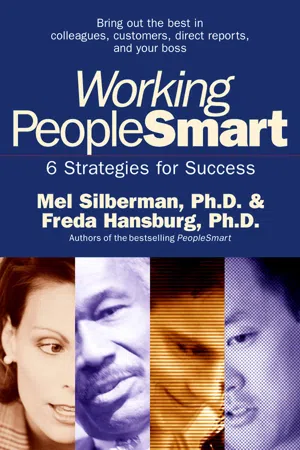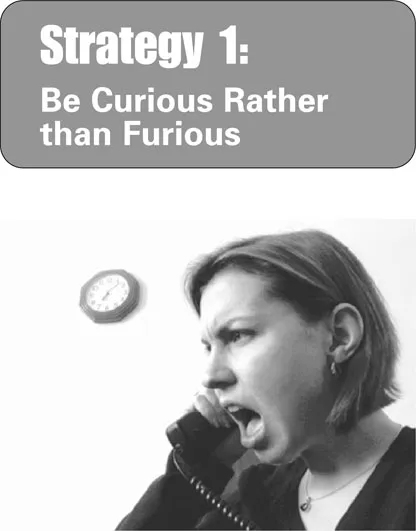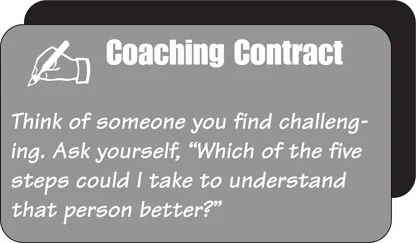We all know people who challenge our ability to work peoplesmart. Do any of these “challengers” sound familiar to you?
Among customers, you might find “Carol Complainer”: “Is this the best you can do?”
Or “Harvey Hierarchy”: “What’s the name of your supervisor?”
Among co-workers, you might find “Needy Nan”: “Can you help me out?” “Want to hear about my weekend?” Or “Superior Stan”: “Mistakes? I never make any… unlike you!”
Among direct reports, you might find “Late Nate”: “No, it was yesterday that the bus was late. Today, I had to take my son to the dentist.” Or “Pathetic Patty”: “I can’t do this! You’ll have to show me how.”
Finally, your boss might be like “Ted Tyrant”: “I’d rather be right than loved!”
Or “Carla Cryptic”: “I don’t have time to go over this. Just figure it out yourself.”
When people at work engage in such unpleasant behavior, it’s only human to be annoyed or even furious. Typically, we might cope by doing any or all of the following:
- Avoid them whenever possible.
- Complain about them to a trusted colleague.
- Write them off as people who can’t or won’t change their ways.
- Respond in kind by being equally unpleasant.
As much as any of these challenging people at work may frustrate us, the people-smart thing to do is get curious as to why they act the way they do rather than merely get upset about what they do. This involves trying to develop an “empathetic understanding” of a person who is puzzling. What is it like to be in this person’s shoes?
You may not like or approve of the other person’s behavior. Certainly, no one should tolerate irresponsible behavior. Nonetheless, it pays to explore why the person acts the way he or she does.
- It may unlock new ways to relate to the person that will be productive for both of you.
- It may give you a new perspective on the person, help you get some distance, and avoid taking what the person does too personally. 9
- It may win the appreciation of that person and serve as the basis for a better relationship.
In contrast, failing to explore the possible causes of the person’s behavior not only perpetuates the impasse but also leads to increasing frustration and, ultimately, cynicism. When we accumulate a list of too many “hopeless cases,” we may become even quicker to write people off and find ourselves walled off from others.
Let’s look at an example of how “furious” might begin shifting to “curious.”
In the accounting office where I work as office manager, there is an accountant named Helen, who couldn’t be more different from me. She always seems down in the dumps, grumbling under her breath and looking angry. She doesn’t respond to jokes and never joins the rest of us in the lunchroom. She just focuses on her work and keeps reminding everybody how much responsibility she has.
I’m a much more social person. I always get my work done, but I also like to talk with people throughout the day, pass along humorous stories via e-mail, and so forth. If we were two of the seven dwarfs, I’d be Happy and Helen would be Grumpy. I know we also have significant differences in our personal lives. Helen is a single mother, living with her elderly parents in their home, both of whom have had some serious health problems. I am married and live with my husband and two of my three young adult daughters in our own home.
Have I written off Helen? I guess if I were in her shoes, I’d feel overwhelmed with responsibilities. Raising a child alone, caring for elderly parents, and then coming to a job where she’s trying to help fatten other people’s bankrolls, when she doesn’t even own a home… that’s pretty bleak. If I were in survival mode like Helen, some of the stuff I talk about, and certainly many of the e-mail jokes I circulate, would probably look pretty superficial.
What really prompted me to reconsider my attitude toward Helen was an office crisis. Someone made a mistake and overlooked an important deadline with one of the accounts. It was Helen who caught the error in time to request an extension. I still wouldn’t want to live with my nose to the grindstone the way she does, but maybe she has a point about responsibility. It rocks my boat to think that perhaps I’ve been a bit smug in my attitude toward her. 10
Although she hasn’t become Helen’s buddy, the office manager has taken a crucial step forward in their relationship. By walking in Helen’s shoes for a few paces, and accepting the possibility that
Helen’s differences aren’t necessarily all deficits, she has opened the door just enough to gain a small glimpse of who may be on the other side.
Five Coaching Tips to Understand Other People Better
Whenever we become frustrated by another person at work, that frustration can eat away at our energy to perform at our best. The good news is that we have several opportunities to “become curious rather than furious.”
When this challenging person talks, give him or her your full attention, without “running your own tape” about what you’ll say next. Try to avoid interrupting what he or she is saying or simply tuning the person out. You might even paraphrase what you hear the person saying, so that he or she gets the idea that you’re really listening.
Undoubtedly, you’ve heard much of what the person is about to tell you before. People have a tendency to repeat themselves. We all have “stump speeches,” much like politicians. However, if you encourage the person to keep talking, he or she might go beyond the usual “stump speech” and tell you things he or she has never said before. That’s when you begin to get the information to help you really understand where this person is coming from. You must make a clear decision that the other person is someone worth listening to and give him or her your full concentration. Imagine a spotlight shining on the speaker. If you are doing something else that could distract you, stop. Instead of working at your desk, for example, consider getting up and moving to another location, in or outside your office, to help you focus on the speaker. Instruct others to not interrupt your time with this person, if necessary. Doing these things may drastically improve how the other person communicates to you. 11
Use open-ended questions to draw out new information and clarify what you are hearing. This is especially important when you are trying to understand a relatively taciturn individual who keeps a lot inside. Open-ended questions invite the speaker to expand or elaborate on his or her message. They offer the person more leeway to respond and share. “What was the upsetting part for you about what he said?” “How do you foresee things getting better on this project?” “Why do you think Bob was so quiet at the meeting?”Use open-ended questions to encourage others to “open up” and share thoughts, feelings, and opinions. By doing so, you increase your chances of learning what’s really important to them. Moreover, the person may respond favorably to your attention and interest.
There are many ways to do this, such as stating or asking
- “I’m not sure I know what your thoughts are about…”
- “Tell me more about this.”
- “What were your reactions/thoughts about… ?”
- “Can you give me an example or two?”
- “How come? Why do you feel that way?”
- “I’ve never asked you about…”
Who seems to have more success with this person? Ask for his or her perspective about your challenger and for suggestions on new approaches to try. Even if you find that everyone you know has the same feelings about this person as you do, they may have different ways of coping. You might approach a colleague and say, “I’ve been really frustrated by _______. What works for you in dealing with him (her)?” The person you are consulting may have some knowledge you lack or a terrific suggestion about how to deal with this challenging individual. If none is forthcoming, at least there are now two of you putting your heads together about this person rather than you tackling the situation all by yourself.12
Imagine that you are the other person and ask yourself how a specific situation would look to you, what you’d be feeling and what your concerns might be. This is not an easy task. It’s hard to put aside your own perspective on the situation.
One suggestion is to appreciate that the other person may look at things differently than you do. For example, you might see the assignments you get as an opportunity to show others how capable you are. The other person might view assignments as simply a job to be done. Although we each have our own preferences and style, it’s important to recognize that different doesn’t necessarily mean better (or worse). Are right-handed people “better” than lefties?
Here are some ways in which the other person may be different from you:
See Table
Reflecting on how the other person’s style may contrast to your own will help you appreciate “their shoes.” Notice, for example, that the opposite end of the continuum from “spontaneous” is “careful,” not “rigid.” A person like Helen, the accountant, someone who is less freewheeling and more deliberate than you, may have a unique contribution to make. 13
Identify how you typically “dance” with this person. Are you avoiding? Critical? Forgiving? Demanding? Be curious enough to see what would happen if you acted dramatically different. For example, you might consider one of the following new behaviors:
- Take extra time to build rapport and establish trust with this person.
- Be firmer and more consistent about what you expect from this person.
- Take a positive approach by reinforcing and encouraging this person.
- Ask this person to tell you about his or her views, needs, and concerns.
- Back off on a big change; focus on little ones.
- Be more honest and straight with this person about what you think and feel.
- Be more persistent with your efforts to influence this person. Don’t let up.
14 Looking at Challenging People
as Anxious People
We realize that getting the energy to act on these five ways to understand others better can be a tall order. You may be so frustrated, angry, or pessimistic at this point in the relationship that it would require from you an awful lot of resolve to refocus.
One of the best ways to develop anew the energy to be “curious rather than furious” is to consider that all human beings, the challenging as well as the pleasant, have three basic human needs:
- Control is the need to have power over one’s life, to be in the driver’s seat instead of the passenger seat.
- Connection is the need for belonging, support, love, and acceptance.
- Competence is the need for success, for demonstrating mastery and being recognized for doing so.
At any given time, we may be anxious about obtaining one or more of these needs. To lessen the anxiety, we might go to one of two extremes: excessively pursue the fulfillment of the need or avoid situations in which the need arises. For example, someone who is anxious about control might act like a “control freak,” who needs everything done his or her way. In contrast, someone who is anxious about being in control may decide to let others call the shots. Someone anxious about connection might act like a social leech while someone else might withdraw or reject others. Someone anxious about competence might be a braggart while someone else might act like a failure.
Imagine you have a co-worker named Steve. Here is how you see him, if you look at him only with fury rather than with curiosity:
Steve is arrogant, opinionated, and sloppy about his work and yet highly critical of others. He often makes crude or insensitive...







